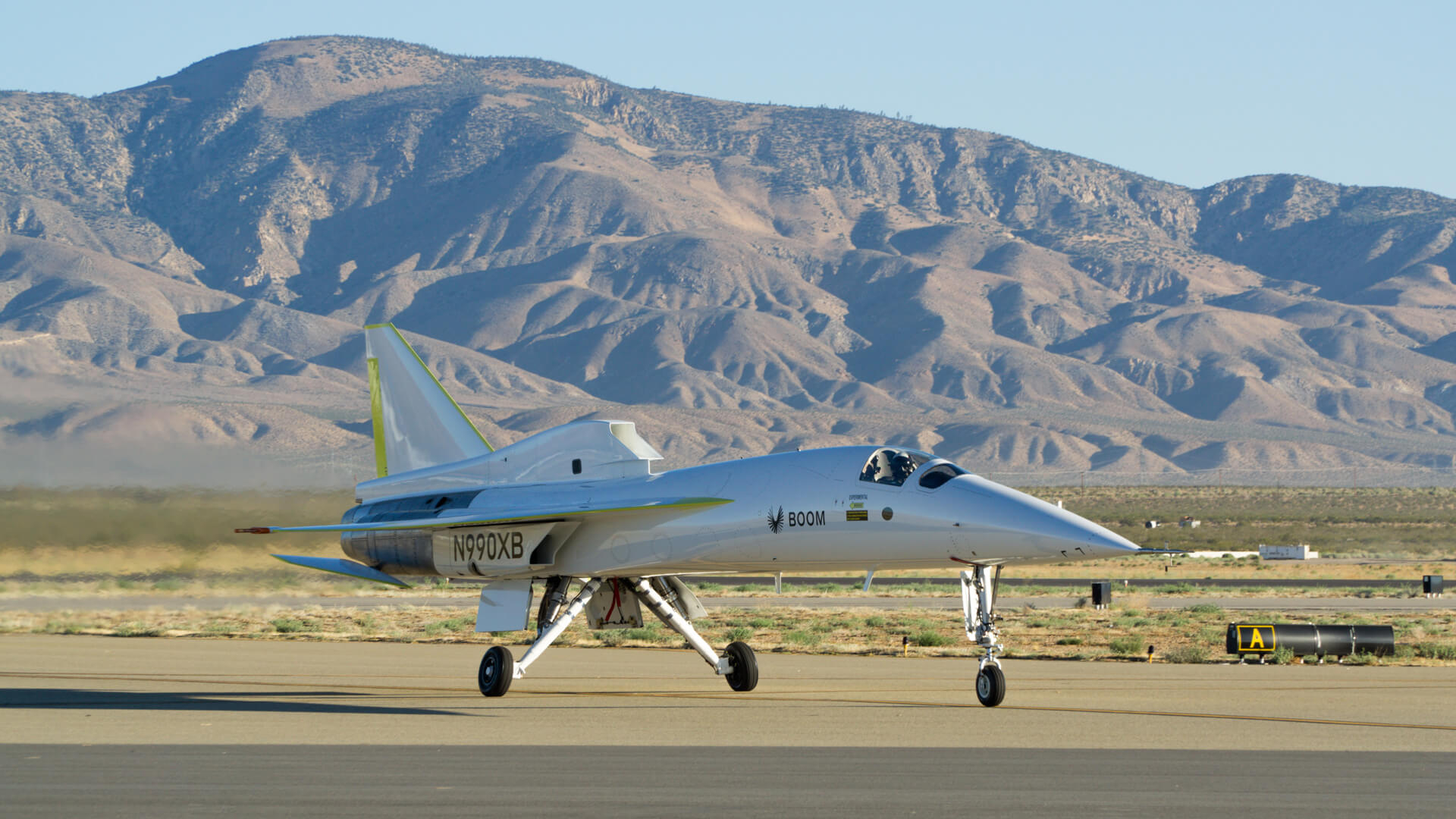Boom's supersonic jet moves toward debut flight (photos)
Boom Technology's faster-than-sound XB-1 jet has completed key milestones on the way to its historic first flight.

A new supersonic jet has completed further milestones on the runway toward its debut faster-than-sound flight.
Aviation startup Boom Technology's XB-1 demonstrator jet has moved from a hangar in Centennial, Colorado, to the Mojave Air and Space Port in California. At Mojave, the 71-foot-long (22 meters) carbon-composite jet has been undergoing extensive ground testing, the company said in a statement, including "taxi testing" this week.
"The recent progress made toward XB-1’s first flight reflects the team’s collective efforts to build and safely fly the world’s first independently developed supersonic jet," Boom Supersonic Founder and CEO Blake Scholl said in the statement.
The plane is designed to fly at Mach 2.2 — 2.2 times the speed of sound, or around 1,700 mph (2,700 kph). The first flight will occur over the Mojave desert in the same patch of airspace where, in October 1947, Chuck Yeager first broke the sound barrier in the Bell X-1 experimental aircraft.
Related: NASA's X-59 'quiet' supersonic jet looks ready to fly in new photos
The XB-1 also recently took another important step toward its first flight, receiving an experimental airworthiness certificate from the U.S. Federal Aviation Administration (FAA) after a detailed aircraft inspection.
Additionally, authorities have approved the use of airspace over the Mojave desert by XB-1, and Boom has letters of authorization to allow Chief Test Pilot Bill "Doc" Shoemaker and test pilot Tristan "Gepetto" Brandenburg to fly the supersonic jet during the test flight.
Breaking space news, the latest updates on rocket launches, skywatching events and more!
"It’s fitting that XB-1 is now progressing toward first flight at the Mojave Air and Space Port, home to more than 50 first flights and other significant aviation events," Shoemaker said. "I’m looking forward to flying XB-1 here, building on the achievements of other talented engineers and pilots who inspire us every day to make supersonic travel mainstream."
Both Boom test pilots have completed hundreds of hours in a simulator and a T-38 trainer jet to help them train for the flight.
According to Boom, the company brought together 60 years of airplane technology, including advancements in carbon fiber composites and advanced avionics, to create the carbon composite body and titanium fuselage of the XB-1.
The supersonic aircraft features a modified delta wing — a wing pairing in the form of a triangle, named for its resemblance to the uppercase Greek letter delta — that not only allows it to reach above Mach 2 but also enables safe takeoff and landing. Boom says that the XB-1 possesses three General Electric J85 engines that provide the jet with a combined thrust of up to 12,300 pounds.
Overtures toward commercial supersonic flight
The XB-1 represents a milestone in the development of Boom's planned commercial airliner, called Overture, which Scholl said could soon make supersonic flight mainstream.
Provided all goes well with XB-1 testing, Boom aims to roll out the Overture craft in 2026, with the first flight of the aircraft planned for no sooner than 2027.
Overture will be a successor to the last commercial supersonic aircraft, the Concorde, which operated between 1969 and 2003. Concorde was grounded due to rising operating costs and falling ticket sales. That latter problem resulted primarily from two factors: the crash of Air France Flight 4590 in 2000, which killed all 109 passengers and crew as well as four people on the ground, and a general downturn in the aviation industry in late 2001 following the Sept. 11 attack on the World Trade Center.
Concorde's last supersonic passenger flight was on Oct. 24, 2003, according to History.com, when it flew at twice the speed of sound between John F. Kennedy International Airport in New York and Heathrow Airport in London carrying 100 passengers.
The 201-foot-long (61 m) long Overture will be capable of reaching a cruising speed of Mach 1.7, traveling over land 20% faster than current commercial aircraft and over water twice as fast as today's fastest airliners. Overture will be capable of carrying between 64 and 80 passengers and will operate on 100% sustainable aviation fuel, Boom says.
According to the company, when operational, the plane should be able to travel between New York and Rome in just 4 hours and 45 minutes, a journey that currently takes around 8 hours, and between San Francisco and Seoul in just over 8 hours, instead of just over 12 hours.

Robert Lea is a science journalist in the U.K. whose articles have been published in Physics World, New Scientist, Astronomy Magazine, All About Space, Newsweek and ZME Science. He also writes about science communication for Elsevier and the European Journal of Physics. Rob holds a bachelor of science degree in physics and astronomy from the U.K.’s Open University. Follow him on Twitter @sciencef1rst.


